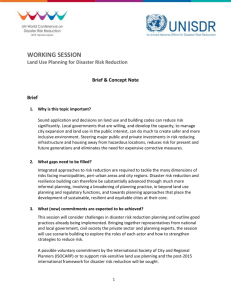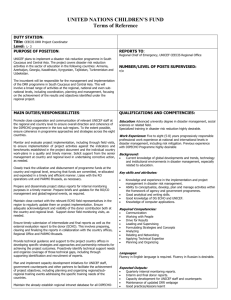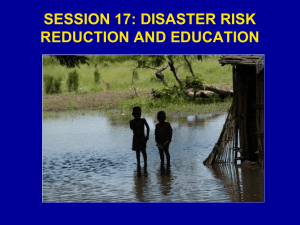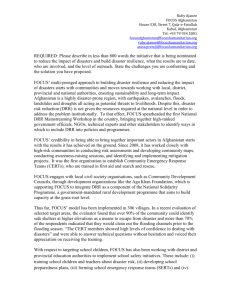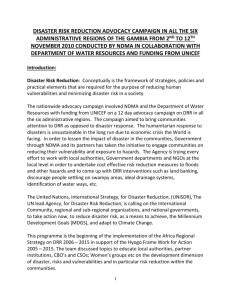Brief and concept note - Third UN World Conference on Disaster
advertisement
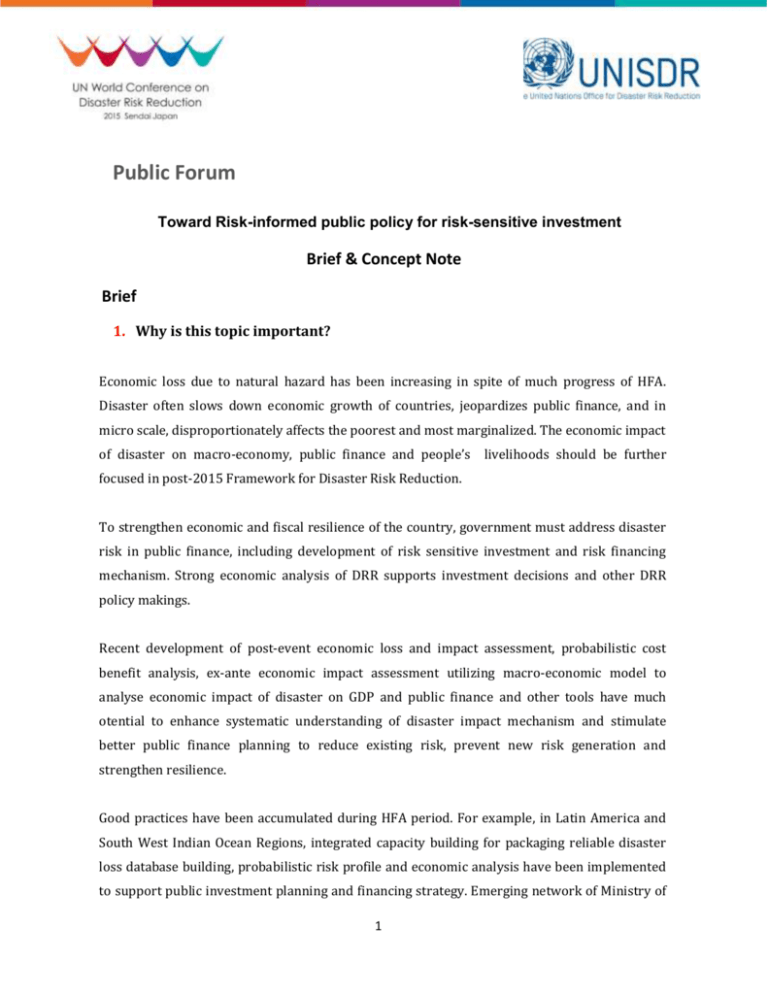
Public Forum Toward Risk-informed public policy for risk-sensitive investment Brief & Concept Note Brief 1. Why is this topic important? Economic loss due to natural hazard has been increasing in spite of much progress of HFA. Disaster often slows down economic growth of countries, jeopardizes public finance, and in micro scale, disproportionately affects the poorest and most marginalized. The economic impact of disaster on macro-economy, public finance and people’s livelihoods should be further focused in post-2015 Framework for Disaster Risk Reduction. To strengthen economic and fiscal resilience of the country, government must address disaster risk in public finance, including development of risk sensitive investment and risk financing mechanism. Strong economic analysis of DRR supports investment decisions and other DRR policy makings. Recent development of post-event economic loss and impact assessment, probabilistic cost benefit analysis, ex-ante economic impact assessment utilizing macro-economic model to analyse economic impact of disaster on GDP and public finance and other tools have much otential to enhance systematic understanding of disaster impact mechanism and stimulate better public finance planning to reduce existing risk, prevent new risk generation and strengthen resilience. Good practices have been accumulated during HFA period. For example, in Latin America and South West Indian Ocean Regions, integrated capacity building for packaging reliable disaster loss database building, probabilistic risk profile and economic analysis have been implemented to support public investment planning and financing strategy. Emerging network of Ministry of 1 Finance for DRR in these regions will further facilitate mutual learning and exchange of good practice in coming post-2015 Framework for Disaster Reduction period. This session will share the good practices during HFA period, and contribute to understanding of the latest advancement of economics in DRR, and discussion of how to combine risk information with economic analysis to produce action oriented and easily understandable new information for policy makers. In Particular, how such analysis stimulate policies to deepen the understanding of risk, reduce existing risk, prevent new risk generation, strengthen resilience. This session will complement Ministerial Roundtable on Public Investment by focusing on methodology and approach to address disaster risk in Public Finance. 2. What gaps need to be filled? While there is more risk information due to development of risk assessment, these assessments only become useful if they are socially appropriated. The priority the people, especially policy makers assign to risk reduction can only be understood in the context of all other economic, social and environmental constraints and opportunities. Economic approach fills the gap by embedding risk information into such context and by delivering risk information in more effective and easily understandable way. The session will address the following gaps: Lack of linkages between natural science (risk information) and social science (especially cost information examined in economics) Insufficient cooperation between Ministry of Finance, public investment planning agency on the one side and disaster management agency on the other side, especially regarding information exchange and sharing Need to explain cost-effectiveness of DRR investment, as compared to expenditure in response and reconstruction Lack of budget monitoring mechanism for DRR, response and reconstruction, which leads to inefficient use of resources An enhanced understanding of the wider socio-economic benefits of DRR, beyond simple avoided-loss calculations. 2 3. What (new) commitments are expected to be achieved ? The analysis accumulated during the decade of HFA have suggested that a risk-layered approach is crucial to manage disaster risk. In the extensive risk layer (high probability and low expected loss), investment in risk reduction is basically the most cost-efficient while in the intensive risk layer (catastrophic event taking place with low probability) risk reduction is often an affordable option and risk financing scheme such as risk transfer would be more cost-efficient. It is important to highlight that DRR efforts decrease the scope for risk financing mechanisms, bringing risk premium down and making insurance more affordable. DRR investment and risk financing mechanisms, therefore, should be considered in synergy to identify the optimum mix in public finance stragey. Cost-efficiency and effectiveness of each option should be examined and presented to support implementation of post-2015 Framework for disaster risk reduction, especially to contribute to reduce economic loss in the period of post-2015 Framework. Under these directions, the voluntary commitments out of this session are as follows: In Latin America, Network of Ministry of Finance on Disaster Risk Reduction is emerging as the platform for information exchange and capacity building for integrating disaster risk into public finance. In the same way, Indian Ocean Region approached the issue through Regional collaboration of Ministry of Finance. Further development of such network to assure mutual learning on economic aspect of DRR and how to integrate economic analysis into public investment and risk financing strategy for DRR is expected as voluntary commitment. Organizations with technical expertise can contribute to such emerging network and DRR community in general by further progressing methodology for economic approach to DRR, and providing technical support and advice to such networks. The establishment of working group of organizations with technical expertise to research and promote economic aspect of DRR, is expected as voluntary commitment. This group is also expected to contribute to the discussion for post-2015 Framework for Disaster Risk Reduction by providing technical advice on measurement of economic loss. This session is to complement Working Session of Economic Aspects of DRR, with more focus on case study introduction. 3 Concept Schedule 15 March, 9:30-11:45 Room and Venue Tohoku University, Kawauchi-Kita Campus B-103 Organizers UNISDR UNISDR Focal Points Kazuko Ishigaki (ishigaki@un.org), Rhea Rhea Katsanakis, Raul Salazar, Julio Serje Background and Rationale The session will start with recognition that economic loss has been increasing and we need to focus on economic aspect of DRR to support sustainable development of society. The session will discuss how economics can be utilized to support better decision making to deepen understanding of risk and its impact on economy, reduce existing risk, prevent new risk generation and strengthen resilience. The session in particular will focus on (a) how risk analysis and economic analysis should be in combination integrated into PUBLIC investment and financing strategy for DRR and (b) how economic information will improve risk communication and raise awareness of policy makers and the public on DRR. As advanced examples, initiatives in Latin American and Indian Ocean region will be introduced. Their achievement and further challenges (e.g. needs for capacity building) will be shared with audience. The session emphasizes the importance of Ministry of Finance and/or Public Investment Planning Agency in facilitating risk-sensitive public investment and introduces recent advanced initiative to support mutual learning at regional networking of Ministry of Finance in Latin America and Indian Ocean regions. This session will also discuss how organizations with technical expertise (especially economic expertise) can contribute to development of risk-sensitive policy making and especially support for emerging regional network of Ministry of Finance. Session Objectives To share the importance of economic approach to DRR, especially utilizing economic analysis and risk information to support decision making in public investment and financing strategies. On this subject, to share the advanced examples achieved in the HFA period, identify further challenges, and suggest direction we should take to implement post-2015 Framework for disaster risk reduction To support emerging regional network of Ministry of Finance for Disaster Risk Reduction and discuss how organizations with technical expertise can support such networks. To facilitate discussion between information user community (policy maker in government) and provider community (organization with technical expertise) by inviting panelists from both sides. 4 Discussion agenda and structure 1. Introduction and welcoming remarks (5mns) 2. Oopening Remark by EC-DEVCO (5 mns) 3. Key note speech to set the context by UNISDR (10mns) 4. Part I: Latin America a. Country presentation: Mexocp (10 mns) b. Country presentation: Peru (10 mns) c. Technical expert presentatioin: JICA (5 mns) d. Technical expert presentation: IDB (5 mns) e. Panel discussion by all 10 panelists (20 mns) Key questions: What are good examples achieved during HFA period regarding this session theme? What are further challenges regarding this session theme in order to support implementation of post-2015 Framework for DRR? 5. Part II: Indian Ocean Region a. Country presentation: Madagascar (10 mns) b. Country presentation: Seychelles (10 mns) c. Technical expert presentation: IIASA (5 mns) d. Technical expert presentation: WB (5 mns) e. Technical expert presentation: CDEMA (5 mns) f. Panel discussion by all 10 panelists (20 mns) Key questions How can economic knowledge (e.g. assessment of economic loss, cost-benefit analysis, macro-economic analysis, budget monitoring) be utilized to support public investment and financing strategies for DRR? What are roles of each stakeholder (e.g. Ministry of Finance, Disaster Management Agency, donor community, private sector etc.)? 6. Wrap up and conclusion by the moderator (10mns) Expected outcomes Commitment / special announcement in support of a post-2015 framework for DRR Shared and documented experiences of good practices and innovations in risk sensitive public investment planning and financing strategies Shared value to recognize the importance of economic analysis of DRR and utilize such analysis to support risk sensitive public investment and risk financing strategies for DRR Policy recommendations to support risk sensitive public investment and risk financing strategies for DRR as a part of implementation strategies for post-2015 Framework for DRR Commitments of emerging Network of Ministry of Finance for DRR and organizations with technical expertise (see below) Commitments of emerging Network of Ministry of Finance for DRR to further facilitate risk sensitive public investment planning and financing strategies Commitments of organizations with technical expertise to support emerging network and DRR community in general by providing 5 systematic technical knowledge (especially economic analysis on DRR). Expected number of participants Background documents 200 Brief issue paper drafted by Co-organizers for working session 16 “Economic Apects of DRR” http://www.wcdrr.org/conference/events/871 UNISDR Working Paper Series on “Disaster Risk in Public Investment and Financing Strategy” (provisional title, forth coming) 6

